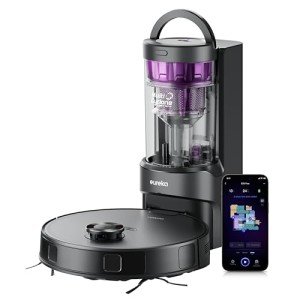Robotic Hoovers: Revolutionizing Home Cleaning
In the fast-paced world we reside in, where time is of the essence, family chores often take a rear seat. Amongst the most substantial improvements in domestic innovation are robotic hoovers, or robotic vacuum. These intelligent devices have transformed the way people approach cleaning their homes, permitting performance and convenience that conventional vacuuming can not match. This post looks into the features, benefits, and future of robotic hoovers, as well as addressing common questions about their performance and upkeep.
What Are Robotic Hoovers?
Robotic hoovers are automated vacuum cleaners created to navigate through rooms and tidy floors without human intervention. They make use of various innovations, consisting of sensors, electronic cameras, and synthetic intelligence, to spot dirt and browse barriers, making them an important addition to modern families.
Secret Features of Robotic Hoovers
Smart Navigation: Most robotic vacuums are geared up with sophisticated sensory innovation that allows them to map and navigate spaces effectively. This includes:
- Lidar Sensors: To produce a map of the home.
- Infrared Sensors: To avoid obstacles and drops (like stairs).
- Cliff Sensors: Prevents the unit from falling off edges.
- Automated Scheduling: Many robotic hoovers can be configured to clean up at specific times, maximizing convenience for users.
- Self-Charging: Most models go back to their docking stations when their battery is low, guaranteeing they are constantly charged and ready to clean.
- App Connectivity: Modern robotic vacuums typically feature apps that enable users to control their devices remotely, set schedules, and even see cleaning maps.
- Several Cleaning Modes: Options such as spot cleaning, edge cleaning, and set up cleaning permit for personalized cleaning regimens based on the home requires.
Advantages of Robotic Hoovers
- Time-Saving: Robotic hoovers can operate independently, releasing up important time for property owners to concentrate on other tasks.
- Consistency: They offer consistent cleaning performance and preserve floor tidiness without the inconsistency that sometimes comes with manual vacuuming.
- Accessibility: With their compact style, robotic hoovers can easily reach under furniture and into tight areas where conventional vacuums battle.
- Maintenance of Various Floor Types: Many robotic vacuum cleaners can adapt to various surfaces, consisting of carpets, wood, tile, and more.
- Integration with Smart Home Systems: They can be connected to smart home gadgets, permitting users to integrate them into their home automation systems.
Comparison of Popular Robotic Hoovers
Here's a short comparison of some popular models in the market:
| Model | Smart Navigation | App Connectivity | Battery Life | Price Range |
|---|---|---|---|---|
| iRobot Roomba 675 | Yes | Yes | 90 minutes | ₤ 250 - ₤ 300 |
| Neato Botvac D7 | Yes | Yes | 120 minutes | ₤ 600 - ₤ 700 |
| Eufy RoboVac 11S | Yes | Restricted | 100 minutes | ₤ 200 - ₤ 250 |
| Roborock S6 | Yes | Yes | 150 minutes | ₤ 500 - ₤ 600 |
| Shark ION Robot | Yes | Yes | 120 minutes | ₤ 250 - ₤ 350 |
Upkeep and Care for Robotic Hoovers
In spite of their automated functions, robotic hoovers need routine maintenance to guarantee their optimum performance. Here are some ideas for preserving a robotic vacuum:
- Empty the Dustbin Frequently: Regular emptying helps preserve suction power.
- Tidy the Brushes: Hair and particles can clog brushes; periodic cleaning avoids this.
- Inspect the Filters: Dirty filters can impede efficiency; they need to be cleaned or replaced as defined by the manufacturer.
- Examine Wheels and Sensors: Ensuring that the wheels are complimentary of obstacles and sensors are tidy will improve navigation and efficiency.
- Update the Firmware: Keeping the robotic vacuum's software application up-to-date can deal with bugs and enhance functionality.
Future of Robotic Hoovers
As technology continues to develop, the capacity for advancements in robotic vacuums is vast. Innovations on the horizon may include:
- Improved AI Capabilities: Enhanced finding out algorithms may allow robotic hoovers to better understand homes and cleaning requirements.
- Combination with More Smart Home Devices: Future models may become a lot more incorporated with home automation systems, improving usability.
- Advanced Cleaning Features: Innovations like mopping capabilities and much deeper carpet cleaning functionality might broaden their utility.
- Sustainability Features: Future designs may include environmentally friendly technologies, such as solar charging or recyclable materials.
Often Asked Questions (FAQs)
How much do robotic hoovers typically cost?
- Prices for robotic hoovers differ significantly depending on features, however usually variety from ₤ 200 to ₤ 800.
How loud are robotic hoovers?
- A lot of robotic vacuums run at a sound level in between 50 to 70 decibels, which is quieter than conventional vacuums.
Can robotic vacuums deal with pet hair?
- Yes, numerous robotic hoovers are designed specifically with powerful suction and brushes to deal with animal hair efficiently.
Do robotic vacuums deal with carpets?
- Absolutely. Most robotic vacuums can clean up different kinds of surface areas including carpets, wood, and tiles.
Do I need to program my robotic vacuum?
- While you can set schedules and choices via an app, lots of models can also run on need or immediately when charged.
In conclusion, robotic hoovers represent an impressive leap in home cleaning technology, using impressive convenience and effectiveness that appeal to modern-day house owners. As technology continues to advance, these devices promise even much better cleaning abilities, even more improving home hygiene and upkeep. For self cleaning vacuum aiming to streamline their cleaning routines, investing in a robotic hoover can be a profoundly gratifying choice.

